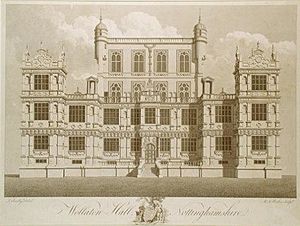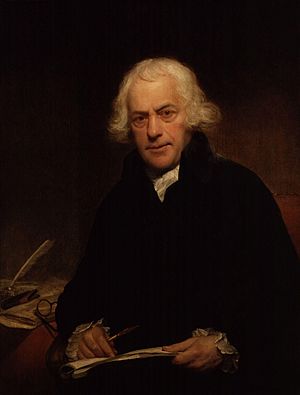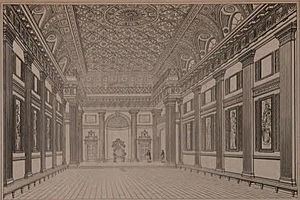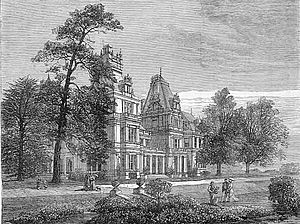Thomas Sandby facts for kids
Thomas Sandby (1721 – 25 June 1798) was an English artist, architect, and teacher. He was very good at drawing and painting with watercolors. In 1743, he started working for the Duke of Cumberland, a powerful royal. Later, the Duke put him in charge of a big part of Windsor Great Park, where Thomas Sandby did a lot of work to design the landscapes.
Along with his younger brother, Paul Sandby, Thomas helped start the Royal Academy in 1768. This was a very important art school. Thomas Sandby became the first professor, or main teacher, of architecture there. One of his most famous buildings was the Freemason's Hall in London, which isn't standing anymore.
Contents
Thomas Sandby's Life and Work

Early Life and Learning
Thomas Sandby was born in Nottingham. His father worked with textiles. Thomas taught himself how to draw and design buildings. His brother, Paul Sandby, also became a famous artist.
Some stories say that Thomas and Paul ran a drawing school in Nottingham. Then, in 1741, they moved to London. They got jobs in the military drawing department at the Tower of London. Another story says Thomas first went to London to get one of his drawings of Nottingham made into a print.
Working for the Duke
In 1743, Thomas Sandby became a special assistant and artist for William Augustus, Duke of Cumberland. He went with the Duke on his military trips in places like Flanders and Scotland from 1743 to 1748. Sandby was even at the Battle of Dettingen in 1743.
He drew pictures of the Duke's trips against rebels. For example, he sketched the Battle of Culloden and drew three wide views of Fort Augustus in 1746. He also drew the special arch built in St. James's Park to celebrate the Duke's victories. In the same year, the Duke became the manager of Windsor Great Park. He chose Sandby to be his assistant manager.
Sandby continued to get paid for his work. Being the assistant manager of Windsor Great Park gave him a good income. This allowed him to use his skills as an artist and architect. He helped make the Great Lodge (now called Cumberland Lodge) bigger for the Duke to live in. Thomas Sandby himself lived in the smaller lodge.
He spent most of his time changing the park and creating the huge Virginia Water Lake. His younger brother, Paul, helped him with this project. In 1754, Thomas made eight drawings of the lake. These were later made into prints by Paul Sandby and others. King George III was very interested in the park project. He trusted Sandby and became his friend. When the Duke of Cumberland died in 1765, the King's brother, Henry Frederick, took over as park manager. He kept Sandby as his assistant.
Artist and Architecture Teacher
Even though Thomas Sandby loved his work at Windsor and preferred a quiet life, he spent some time in London each year. He was part of a group that wanted to start an art academy. In 1767, he showed his drawings at an art exhibition.
In 1768, both Thomas and his brother Paul were among the first 28 people chosen by King George III to start the Royal Academy. Thomas Sandby was chosen as the Academy's first professor of architecture. He gave his first lecture on October 8, 1770. He continued to give these lectures every year until he died. The lectures were never published, but his drawings for them were sold after his death.
Designing Buildings
In 1769, Sandby entered a contest to design the Royal Exchange in Dublin. He won third prize. Perhaps his most important building design was the first Freemason's Hall in central London. This building opened with a big ceremony on May 23, 1776. The Freemasons gave him the special title of 'Grand Architect'. The Hall was made bigger later, but it was torn down in 1930 after being badly damaged by a fire.
Sandby also designed a carved wooden screen for St. George's Chapel, Windsor Castle. He designed a stone bridge over the River Thames at Staines, which opened in 1796. However, it was taken down a few years later because it wasn't safe. He built several houses near Windsor, including St Leonard's Hill for the Duchess of Gloucester. In 1777, he was named an architect for the King's projects.
Family Life
Thomas Sandby was married twice. His second wife was Elizabeth Venables. They married on April 26, 1753. They had ten children together, and six of them (five daughters and one son) were still alive when he died. After his wife died, his daughter Harriott helped take care of him. She later married his brother Paul's son, Thomas Paul.
His Death
Thomas Sandby died at his home in Windsor Park on June 25, 1798. He was buried in the churchyard of Old Windsor.
What He Left Behind
Even though Thomas Sandby taught himself architecture and didn't build many buildings, the Freemasons' Hall showed his great talent. His work at Windsor Great Park and the Virginia Water Lake are lasting examples of his skill as an engineer and landscape designer. He was an excellent artist who could draw many different things. He was also so good with watercolors that his name should be remembered alongside his brother Paul's in the history of art.
Images for kids





